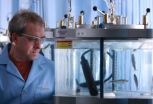(Press-News.org) Penicillin, one of the scientific marvels of the 20th century, is currently losing a lot of battles it once won against bacterial infections. But scientists at the University of South Carolina have just reported a new approach to restoring its combat effectiveness, even against so-called "superbugs."
Bacteria have been chipping away at the power of the penicillin family of drugs since their first wide-scale use as antibiotics in the 1940s. For example, the staph infection, brought about by the bacterium Staphylococcus aureus, was once readily treated with penicillin and its molecular cousins.
But that bug has changed. In the 1960s, a new strain arrived, termed MRSA for methicillin- (or sometimes multidrug-) resistant S. aureus. It has become a serious public health problem because the earliest deployed antibiotics are often useless against the new strain, and its prevalence has only increased since it was first observed. MRSA (pronounced mer-suh) is sometimes called a superbug because of the difficulty physicians have in treating infected patients.
The S. aureus microbe has evolved the MRSA strain by developing a variety of defenses against antibiotics to which they've been exposed. One of those defenses effectively neutralizes penicillin's greatest strength.
That strength is its molecular core, a cyclic four-membered amide ring termed a beta-lactam. It is a common structural element of the penicillins, their synthetic and semi-synthetic derivatives, and other related molecules that constitute the broad family of drugs called the beta-lactam antibiotics. Just a few examples (of dozens) include amoxicillin, ampicillin and cefazolin.
The beta-lactam structure in a molecule is something that many bacteria don't like at all. It greatly hinders their ability to reproduce by cell division, and so chemists have for years spent time making molecules that all contain the beta-lactam structural motif, but differ in the surrounding molecular "shrubbery." Physicians heavily use the many versions of beta-lactam antibiotics to fight bacterial infections, and many have been retired because they're no longer effective against the defenses bacteria have evolved in response.
One of the most effective bacterial defenses is an enzyme called beta-lactamase, which chews up the beta-lactam structure. Some bacteria, such as MRSA, have developed the ability to biosynthesize and release beta-lactamase when needed. It's a devastating defense because it's so general, targeting the common structural motif in all of the many beta-lactam antibiotics.
But that also creates the opportunity for a general approach to solving the problem, which is what Carolina's Chuanbing Tang and colleagues just reported in the Journal of the American Chemical Society.
"Instead of developing new antibiotics, here we ask the question, 'can we recycle the old antibiotics?' " he said. "With traditional antibiotics like penicillin G, amoxicillin, ampicillin and so on, can we give them new life?"
The approach pairs the drug with a protective polymer developed in Tang's chemistry laboratory. In lab tests, graduate student Jiuyang Zhang prepared a cobaltocenium metallopolymer that greatly slowed the destructiveness of beta-lactamase on a model beta-lactam molecule (nitrocefin).
The interdisciplinary team, which included Mitzi Nagarkatti and Alan Decho, from the university's School of Medicine and Arnold School of Public Health, respectively, also showed that the antimicrobial effectiveness of the four beta-lactams studied in detail was enhanced by the polymer. The enhancement was modest against two strains, but very pronounced with the hospital-associated strain of MRSA (HA-MRSA).
The metallopolymer by itself even demonstrated antimicrobial properties, lysing bacterial cells while leaving human red blood cells unaffected. By a variety of measures, the polymer was found to be nontoxic to human cells in laboratory tests.
The project is still far from clinical use, but Tang knows moving forward is imperative.
"In the United States every year, around 100,000 patients die of bacteria-induced infections," Tang said. "And the problem is increasing because bacteria are building resistance.
"It's a really, really big problem, not only for individual patients, but also for society."
INFORMATION:
Penicillin redux: Rearming proven warriors for the 21st century
2014-04-14
ELSE PRESS RELEASES FROM THIS DATE:
Study links severe sleep apnea to increased risk of stroke, cancer and death
2014-04-14
DARIEN, IL – A new study shows that moderate to severe obstructive sleep apnea is independently associated with an increased risk of stroke, cancer and death.
Results of the 20-year follow-up study show that people with moderate to severe obstructive sleep apnea were four times more likely to die (hazard ratio = 4.2), nearly four times more likely to have a stroke (HR = 3.7), three times more likely to die from cancer (HR = 3.4), and 2.5 times more likely to develop cancer. Results were adjusted for potential confounding factors such as body mass index, smoking status, ...
Shared decision making during radiation therapy improves patient satisfaction
2014-04-14
PHILADELPHIA—Playing an active role in their radiation treatment decisions leaves cancer patients feeling more satisfied with their care, and may even relieve psychological distress around the experience, researchers from the Perelman School of Medicine at the University of Pennsylvania report in the journal Cancer.
In a study of 305 patients undergoing radiation treatment, Neha Vapiwala, MD, an associate professor in the department in Radiation Oncology at Penn Medicine, and colleagues at link "Penn's...Center: Penn's Abramson Cancer Center found an association between ...
Plague alters cell death to kill host
2014-04-14
Northwestern Medicine scientists are continuing to unravel the molecular changes that underlie one of the world's deadliest and most infamous respiratory infections.
When the bacterium Yersinia pestis enters the lungs, it causes pneumonic plague, a disease that is 100 percent fatal if untreated. The way in which Y. pestis evades the immune system and kills people in a matter of days has largely confounded scientists, until now.
Following a 2007 study demonstrating that the presence of a protein called the plasminogen activator protease (Pla) is required for Y. pestis ...
Climate change a likely culprit in coqui frog's altered calls, say UCLA biologists
2014-04-14
Changes in the Puerto Rican climate over the past three decades have caused small but significant changes to the coqui frog, the territory's national animal. UCLA biologists have found that not only have male coquis become smaller, but their mating call has also become shorter and higher pitched.
Authored by Peter Narins, UCLA distinguished professor of integrative biology and physiology and of ecology and evolutionary biology, and Sebastiaan Meenderink, a UCLA physics researcher, the study examined 170 male coqui frogs (Eleutherodactylus coqui) in 1983 and then 116 ...
Making dams safer for fish around the world
2014-04-14
RICHLAND, Wash. – Think of the pressure change you feel when an elevator zips you up multiple floors in a tall building. Imagine how you'd feel if that elevator carried you all the way up to the top of Mt. Everest – in the blink of an eye.
That's similar to what many fish experience when they travel through the turbulent waters near a dam. For some, the change in pressure is simply too big, too fast, and they die or are seriously injured.
In an article in the March issue of the journal Fisheries, ecologists from the Department of Energy's Pacific Northwest National ...
Cosmic slurp
2014-04-14
Somewhere in the cosmos an ordinary galaxy spins, seemingly at slumber. Then all of a sudden, WHAM! A flash of light explodes from the galaxy's center. A star orbiting too close to the event horizon of the galaxy's central supermassive black hole is torn apart by the force of gravity, heating up its gas and sending out a beacon to the far reaches of the universe.
In a universe with tens of billions of galaxies, how would we see it? What would such a beacon look like? How would we distinguish it from other bright, monumental intergalactic events, like supernovas?
"Black ...
Researchers identify children with emotional behavior difficulties
2014-04-14
Research on children orphaned by HIV/AIDS in South Africa may provide insight on how to identify and help children with emotional behavior issues in other areas of the world, which may have limited access to healthcare and further research that could lead to successful interventions.
A report on the global AIDS epidemic published by the United Nations mentions that due to the HIV/AIDS pandemic, which has left 12 million children orphaned in Sub-Saharan African, children are at an increased risk for mental health problems.
"There has been a big push to understand what ...
Henry Ford Hospital hits new heart valve surgery milestone
2014-04-14
DETROIT – Doctors at Henry Ford Hospital reached a medical milestone April 3, performing the 25th successful transcatheter valve replacement using a novel way to access the heart.
Henry Ford is the only hospital in the United States performing the unique procedure called transcaval valve replacement, which accesses the heart by temporarily connecting major blood vessels.
Northern Michigan resident Viola Waller, 80, underwent Henry Ford's first transcaval procedure on July 3, 2013 when traditional valve replacement was not medically viable.
"Nobody could help me here," ...
Dog ownership benefits families of children with autism, MU researcher finds
2014-04-14
COLUMBIA, Mo. –Many families face the decision of whether to get a dog. For families of children with autism, the decision can be even more challenging. Now, a University of Missouri researcher has studied dog ownership decisions in families of children with autism and found, regardless of whether they owned dogs, the parents reported the benefits of dog ownership included companionship, stress relief and opportunities for their children to learn responsibility.
"Children with autism spectrum disorders often struggle with interacting with others, which can make it difficult ...
Rare bone diseases and their dental, oral and craniofacial manifestations
2014-04-14
Alexandria, Va., USA – The International and American Associations for Dental Research (IADR/AADR) have published a paper titled "Rare Bone Diseases and Their Dental, Oral, and Craniofacial Manifestations." The complete review by researchers Sunday O. Akintoye, Andrea B. Burke, Alison M. Boyce, Michael Collins, Brian L. Foster, Rachel I. Gafni, Janice S. Lee, Mary Scott Ramnitz, Martha J. Somerman and J. Timothy Wright is published in the OnlineFirst portion of the IADR/AADR Journal of Dental Research (JDR).
Hereditary diseases affecting the skeleton are heterogeneous ...






